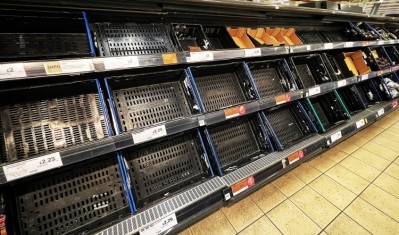News
Food most targeted in supply chain thefts

Food and drink theft on the rise
Between 2021-22, food and beverages remained the most commonly stolen commodity, with incidences of such theft rising considerably in 2022 (+2.8% share).
Cargo thieves are also targeting fuel products, which saw a rise from 5.9% in 2021 to 10.3% in 2022. Interestingly, spikes were seen during both third quarters.
Overall, theft from facilities now account for more than a quarter of total thefts – from hijacking, to theft from containers, and theft of vehicles, among other types analysed in BSI's report.
While hijacking cargo incidents dropped in 2022, the British Standards Institution (BSI) observed that this continues to have a big impact on global supply chains, with food among the sectors most effected.
Meanwhile, we’re also seen a number of labour strikes and labour shortages, with large scale industrial action taking place across the US, UK and other markets. The transport sector was hit particularly hard, with strikes in Liverpool and Felixstowe in the UK causing huge disruption.
Inflation and cybercrime
Russian’s invasion on Ukraine, alongside Covid-related shutdowns has also triggered record high inflation and shortages in food and other key manufacturing components, whilst the energy crisis continues to apply pressure onto supply chains and cargo security.
BSI notes that the prolonged shortage of key manufacturing components has ‘awakened’ governments to the importance of global supply chains to national interest, and several new laws have come into play as a result across the US and EU.
The report also highlighted a rising number of cyberattacks on the supply chain with increasing sophistication.
“Cyber criminals are targeting an already stressed supply chain, whether it be the port of Hamburg in Europe or IT at the port of Bangladesh in Asia, and cargo thieves are targeting higher value goods, whether it be based on demand, like food and beverage products, or based on shortages, like electronic goods,” the report reads.
Unprecedented volatility requires serious intervention
Commenting on the results, Susan Taylor Martin, chief executive of BSI, said: “2022 saw volatility in global supply chains that many would never have expected in their lifetime.
“Successive crises, including a global pandemic followed by a war in Europe, have resulted in continued uncertainty on many fronts and have demonstrated to governments the benefit of ensuring a robust global supply chain.
“Given the turbulence of the last twelve months, 2023 will be an important watershed for many organisations – with those that successfully manage their supply chain risks being more likely to thrive.”
Five areas of focus have been flagged by the report to help enable future growth and financial sustainability. These are as follows:
- Leadership: Supply chain continuity requires investment from the top down and what organisations really need right now is strong buy-in from top level leadership.
- Digital: Organisations need to urgently address their digital risk, with BSI reporting that 73% are significantly concerned about the risks posed by the digitisation of supply chains, but not one organisation having resolved the risk.
- Self-knowledge: Organisations need to invest in tools and technology which help them form a comprehensive understanding of their supply chain environment, such as data analysis, IoT, cloud computing, information security and predictive analysis.
- A tailored approach: An awareness of the different, unique challenges facing each sector’s supply chain is key.
- New technologies: Data, the metaverse and cybersecurity are segments of technology that will differentiate organisation’s approach to building strong supply chains.
Commenting further, Jim Yarbrough, global intelligence program manager at BSI noted that while the threats facing global supply chains varied in severity and nature between 2021 and 2022, rampant global price inflation left everyone in a more precarious situation.
Offering words of caution, he said: “Without intervention, businesses will see dramatic impacts on their bottom line, meaning that discussing supply chain issues at the C-suite level can help to ensure investments are funneled to suppliers, building resilience to threats and supporting financial sustainability.”


















